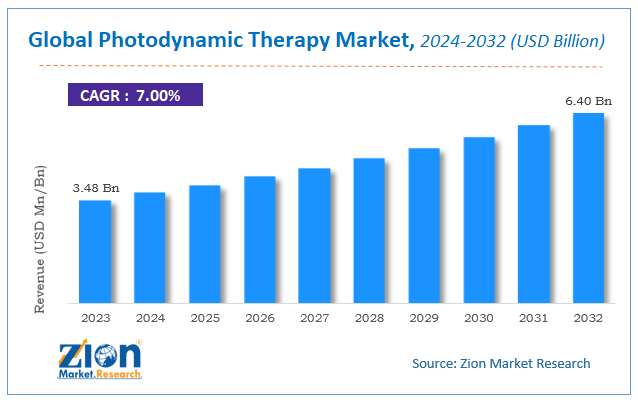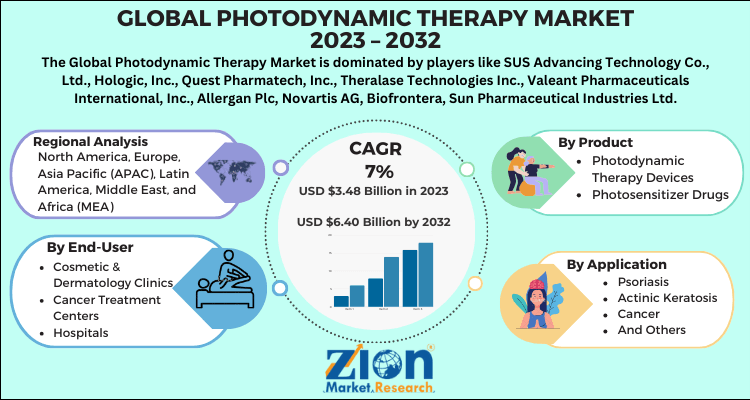Photodynamic Therapy Market Size, Share, Trends, Growth and Forecast 2032

Photodynamic Therapy Market By End-user (cosmetic & dermatology clinics, cancer treatment centers, hospitals, and others), By Application (psoriasis, actinic keratosis, cancer, and others), By Product (photodynamic therapy devices and photosensitizer drugs) And By Region: - Global And Regional Industry Overview, Market Intelligence, Comprehensive Analysis, Historical Data, And Forecasts, 2024-2032
| Market Size in 2023 | Market Forecast in 2032 | CAGR (in %) | Base Year |
|---|---|---|---|
| USD 3.48 Billion | USD 6.40 Billion | 7% | 2023 |
Description
Photodynamic Therapy Market Insights
According to the report published by Zion Market Research, the global Photodynamic Therapy Market size was valued at USD 3.48 Billion in 2023 and is predicted to reach USD 6.40 Billion by the end of 2032. The market is expected to grow with a CAGR of 7% during the forecast period. The report analyzes the global Photodynamic Therapy Market's growth drivers, restraints, and impact on demand during the forecast period. It will also help navigate and explore the arising opportunities in the Photodynamic Therapy industry.
Global Photodynamic Therapy Market: Overview
Photodynamic therapy is considered to be the safest procedure to treat viral infections. Photodynamic therapy is a treatment given for cancer, macular degeneration, actinic keratosis, acne, and other diseases. This therapy utilizes photosensitizing agents integrated with light energy. The treatment reveals promising results by working directly on the damaged cell with the help of activated oxygen that destroys only the targeted cells. It is a widely adopted treatment for a number of diseases as it effectively prevents healthy cells from being damaged and causing scarring. It is the most effective treatment for cancer. Also, photodynamic therapy has turned out an effective treatment in multidrug-resistant breast cancer.
Global Photodynamic Therapy Market: Growth Factors
Cancer accounts for the largest application of photodynamic therapy globally. Also, healthcare companies are creating awareness among people regarding the existence of photodynamic therapy and its effective treatment against breast cancer-resistant patients. It is effectively being used as a substitute to broad-spectrum antibiotic-based therapy which also minimizes the cases of drug resistance. In addition, companies are effectively propelling their research and development activities to access the photodynamic therapy-resistant cell to further analyze and examine the impact of the same on cellular targets. Also, healthcare providers are trying to increase the efficacy of these therapies in photosensitizer levels with its retention in the target cell.
However, the growing incidences of actinic keratosis are the key reason for the growth of the global photodynamic therapy market. Dermoscopy is a vital tool for monitoring skin lesions during such therapy and in follow-up procedures. Professionals are using photodynamic therapy for treating actinic keratosis disease with aminolevulinic acid (ALA) drugs. These drug agents are gaining immense popularity and are widely being adopted in photodynamic therapy. Dermoscopy monitoring is highly used in photodynamic therapy as it is a non-invasive technique that not only plays a valuable role in diagnosing actinic keratosis but also several other wide ranges of skin diseases. The high sale of photosensitizer drugs is steering the growth of the global photodynamic therapy market as manufacturers are raising the complexity of drug molecules to avoid replication by competitors.
For instance, Australia contains the largest cases of actinic keratosis followed by the US. Therefore, both regions are serving as the great marketplace for the growth of photodynamic therapy. Furthermore, the technological advancements in the field of dynamic therapy are likely to bring several innovations and modernization in the treatment of the aforementioned diseases. The key market players and government authorities are boosting the funding to increase the research and development activities in the field of photodynamic therapy.
Global Photodynamic Therapy Market: Segmentation
The global photodynamic therapy market can be segmented into end-user, application, product, and region.
By end-user, the market can be segmented into cosmetic & dermatology clinics, cancer treatment centers, hospitals, and others. The cosmetic & dermatology clinic segment accounts for the largest share in the global photodynamic therapy market due to the growing cases of skin-associated problems like actinic keratosis, acne, psoriasis, and several others. Furthermore, it is a non-invasive and cost-effective treatment possessing high capabilities to treat multiple skin lesions. Also, the cancer segment is expected to grow significantly in the forthcoming years due to the growing incidences of cancer globally.
By application, the market can be segmented into psoriasis, actinic keratosis, cancer, and others. The cancer segment holds the largest share in the global photodynamic therapy market due to its growing prevalence.
By product, the market can be segmented into photodynamic therapy devices and photosensitizer drugs. The photosensitizer drug segment dominates the global photodynamic therapy market due to its wide range of applications in ophthalmology, ontology, and dermatology.
Photodynamic Therapy Market: Report Scope
| Report Attributes | Report Details |
|---|---|
| Report Name | Photodynamic Therapy Market |
| Market Size in 2023 | USD 3.48 Billion |
| Market Forecast in 2032 | USD 6.40 Billion |
| Growth Rate | CAGR of 7% |
| Number of Pages | 193 |
| Key Companies Covered | SUS Advancing Technology Co., Ltd., Hologic, Inc., Quest Pharmatech, Inc., Theralase Technologies Inc., Valeant Pharmaceuticals International, Inc., Allergan Plc, Novartis AG, Biofrontera, Sun Pharmaceutical Industries Ltd., and Galderma S.A. |
| Segments Covered | By end-user, By application, By product and By Region |
| Regions Covered | North America, Europe, Asia Pacific (APAC), Latin America, Middle East, and Africa (MEA) |
| Base Year | 2023 |
| Historical Year | 2018 to 2022 |
| Forecast Year | 2024 - 2032 |
| Customization Scope | Avail customized purchase options to meet your exact research needs. Request For Customization |
Global Photodynamic Therapy Market: Regional analysis
North America accounts for the largest share in the global photodynamic therapy market due to the high prevalence of various skin disorders and cancer in the region. Furthermore, the ongoing technological advancements in the region in the field of photodynamic therapy will further accentuate the growth of the regional market. Moreover, the growing awareness among people regarding the effective treatment by photodynamic therapy will also fuel the adoption of such therapies in the region.
Asia Pacific is expected to be the fastest-growing region in the global photodynamic therapy market due to the growing initiatives from the government to strengthen the healthcare infrastructure and simultaneously lower the burden of growing diseases in the region.
Global Photodynamic Therapy Market: Competitive Players
Some of the significant players in the global photodynamic therapy market are:
- SUS Advancing Technology Co., Ltd.
- Hologic, Inc.
- Quest Pharmatech, Inc.
- Theralase Technologies Inc.
- Valeant Pharmaceuticals International, Inc.
- Allergan Plc
- Novartis AG
- Biofrontera
- Sun Pharmaceutical Industries Ltd.
- Galderma S.A. Also
the various growth initiatives like collaborations and partnership in the global photodynamic therapy market are positively shaping the growth trajectory.
The Global Photodynamic Therapy Market is segmented as follows:
By End-user
- cosmetic & dermatology clinics
- cancer treatment centers
- hospitals
- and others
By Application
- psoriasis
- actinic keratosis
- cancer
- and others
By Product
- photodynamic therapy devices
- photosensitizer drugs
Global Photodynamic Therapy Market: Regional Segment Analysis
- North America
- The U.S.
- Canada
- Europe
- France
- The UK
- Spain
- Germany
- Italy
- Rest of Europe
- Asia Pacific
- China
- Japan
- India
- South Korea
- Southeast Asia
- Rest of Asia Pacific
- Latin America
- Brazil
- Mexico
- Rest of Latin America
- Middle East & Africa
- GCC
- South Africa
- Rest of Middle East & Africa
What Reports Provides
- Full in-depth analysis of the parent market
- Important changes in market dynamics
- Segmentation details of the market
- Former, on-going, and projected market analysis in terms of volume and value
- Assessment of niche industry developments
- Market share analysis
- Key strategies of major players
- Emerging segments and regional markets
- Testimonials to companies in order to fortify their foothold in the market.
Table Of Content
FrequentlyAsked Questions
Healthcare providers are trying to increase the efficacy of these therapies in photosensitizer levels with its retention in the target cell. However, the growing incidences of actinic keratosis are the key reason for the growth of the global photodynamic therapy market.
North America accounts for the largest share in the global photodynamic therapy market due to the high prevalence of various skin disorders and cancer in the region. Furthermore, the ongoing technological advancements in the region in the field of photodynamic therapy will further accentuate the growth of the regional market.
Some of the significant players in the global photodynamic therapy market are SUS Advancing Technology Co., Ltd., Hologic, Inc., Quest Pharmatech, Inc., Theralase Technologies Inc., Valeant Pharmaceuticals International, Inc., Allergan Plc, Novartis AG, Biofrontera, Sun Pharmaceutical Industries Ltd., and Galderma S.A.
HappyClients
Zion Market Research
Tel: +1 (302) 444-0166
USA/Canada Toll Free No.+1 (855) 465-4651
3rd Floor,
Mrunal Paradise, Opp Maharaja Hotel,
Pimple Gurav, Pune 411061,
Maharashtra, India
Phone No +91 7768 006 007, +91 7768 006 008
US OFFICE NO +1 (302) 444-0166
US/CAN TOLL FREE +1 (855) 465-4651
Email: sales@zionmarketresearch.com
We have secured system to process your transaction.
Our support available to help you 24 hours a day, five days a week.
Monday - Friday: 9AM - 6PM
Saturday - Sunday: Closed






